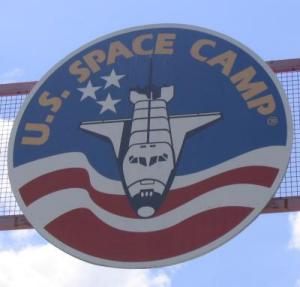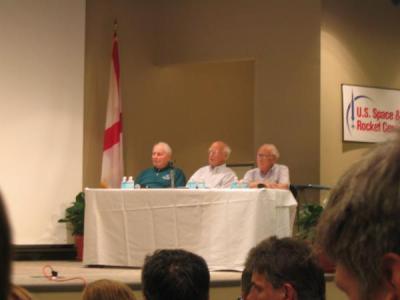
A week at Space Camp

A week at Space Camp
It started with a competition for students age 15 to 18 set by the Austrian Board of Eduacation and the Austrian Research Promotion Agency. Participants had to write an English essay about the European satellite navigation system "Galileo". One of my students, Reinhard Tlustos, 17, decided to participate - and won! (His essay can be found here on our school's homepage.) The prize was one week at the International Space Camp in Huntsville, Alabama, for himself an a teacher. The lucky teacher was me! The second winner was a girl from another school in the same distict of Vienna, Ricarda Erhard, 15. The three of us did not really know what exactly was waiting for us at Huntsville but we were very excited and we knew that this was going to be a unique experience.
Huntsville is a city where history was made. Here Wernher von Braun and his team constructed the rockets that took the first Americans into space and to the Moon. Today the Marshall Space Flight Center in Huntsville is one of several important NASA centers.
The U.S. Space & Rocket Center in Huntsville features a great museum about the history of rocket science and space travel, a rocket park and many other attractions. Part of the Center is Space Camp which gives children and grown-ups alike the possibility to experience life as an astronaut.

Welcome to U.S. Space and Rocket Center
|
|
|

A real Saturn V, waiting for a new exhibit
|
|
|
Right after arrival we were met by Dan from Space Camp and taken to our dorms. Teachers and students had completely different schedules, so I hardly ever met Reinhard and Ricarda during the week. This year's participants at the International Space Camp were the "Teachers of the Year" of 48 US States and five US territories plus 24 international teachers from Europe, Asia, Australia and New Zealand. Each of the international teachers came with two students who were joined by US students from different US States.

Teachers dorms at the Campus of the University of Alabama at Huntsville.
On Saturday evening the International Space Camp was officially opened. In the course of the opening ceremony each US teacher and each international team had to represent their state. This led to a promenade of colorful costumes, among them a walking lake (Minnesota), Old (not the lady in the costume!) Faithful (Wyoming) and an - almost - authentic racehorse plus rider (Kentucky).
Back home Ricarda and Reinhard had practiced dancing the Vienna Waltz for this occasion and it was worth the effort! A perfect "Handkuss" and a few turns of the Waltz earned them a huge applause.
|
|
|
On Sunday the Space Camp schedule started. We teachers were split up in teams of 15 or 16, each team was named after a module of the ISS. I was part of Team ZARYA (the first module of the ISS) together with collegues from the Netherlands, Russia, the Czech Republic, Norway, Singapour and 10 US States. In the course of the week each team had to design a mission patch. Thanks to Ron from New Mexico and his skills on the computer ours turned out especially pretty!

Team ZARYA mission patch
Part of the program consited of talks and workshops about various space related topcis. Among the many informative and interesting talks I would like to mention the one by fromer astronaut Frank L. Culbertson, who had spent over four months on the ISS and who told us lots of humorous stories and interesting facts about life in space. He also witnessed 9/11 from space - even from this distance a shocking and devastating sight.

The burning World Trade Center seen from space
A special highlight - especially for me as a history teacher - was the talk given by six former rocket scientists (three from the USA and three Germans) who had worked with Wernher von Braun.

Three elderly gentlemen who have made history
Between the activities, on the way from one building to the other, I could not take my eyes off the most impressive item on display: the Space Shuttle Pathfinder, which was used for various tests.
|
|
|

An impressive sight - every single day
All of us had most fun in the two "missions" we, as Team ZARYA, had to do on the simulators. We were assigned differnent tasks in Mission Control (MOCR), the orbiter or on the ISS. Each of us had a script which gave us the lines and commands we had to use together with the timeline. So we sounded quite professional - most of the time. Two councellors of Space Camp sent us several C&W (Caution and Warnings), but we brought both missions to a good ending and landed the orbiter safely. - At least they were kind enough to let us believe that.
|
|
|
|
|
|

The orbiter has landed!
In the second mission Valerij, my Russian collegue, and I were the mission specialists, who had to do an EVA (extra vehicular activity), commonly called a spacewalk. Suspended in the air on two special chairs simulating microgravity, we had to build part of a truss. Not an easy task, if you have to hold on to the construction with your rubber boots and work with your hands at the same time. It was good that we had to wear cooling vests. We needed them!

Doing the "spacewalk"

Not quite so easy
But there were more activities to come: a simulated parachute landing in the water, a ride on the multi axis trainer and some awkward jumps on the 1/6 gravity chair were some of the things we could try out. We were definitely never bored!
|
|
|
Friday (and Saturday) brought the absolute highlight of the week for us teachers: Northrop Grumman, the company working on the new Crew Exploration Vehicle, had sponsored parabolic flights for all the teachers of the International Space Camp. In this flight weightlessnes is achieved by flying 15 parabolic flight maneuvers. When I was informed about this unique opportunity last May I was quickly determined to do this. Nevertheless I had mixed feelings about it. Would I feel ok during this flight? I am easily affected by motion sickness, and 15 parabolas sounded a lot! But all my worries were unfounded. Staff of the ZERO G company informed us in detail what we had to expect, and the whole flight is so stomach-friendly that all of us (with one unfortunate exception) could enjoy it to the last minute.
|
|
|

The first of four ZERO G flight teams
Take off and landing were just like a normal flight, sitting in regular seats in the rear section of the plane. As soon as we had reached the right altitude we had to lie down on the floor in the empty front section of the plane and wait. As there are no windows you do not notice anything of the flight maneuvers. One has to imagine the flight path like a jump over a giant ramp. At the beginning of each parabola (going "up the ramp") you experience 1,8 g. It feels good to lie down during this phase. Once the plane has reached the "top of the ramp" and begins to "jump" you get lighter and lighter and within a few seconds you are weightless. A little movement is enough to push you up to the ceiling and make you float in the air. It is an indescribable, fantastic experience that lasts far too short! After 25 seconds you hear the commands "Feet down! Get down!" and you lie down again, going through the next 1,8 g passage. All in all we flew 15 parabolas in four blocks with short breaks in between. The first one took us to 1/3 g (gravitation on Mars), then followed a few parabolas with 1/6 g (gravitaion on the Moon). The 10 parabolas with zero g (or rather microgravity) went by much too fast. I had to force myself to do at least one of my experiments - the one that I had been looking forward to most: I squeezed a little bit of water out of a bottle and tried to catch the waterbubble with the mouth. I was thrilled to see that water REALLY forms a bubble in microgravity and I succeeded once in catching one!
|
|
|
The ZERO G company had installed cameras inside the plane and later sent us the video of our flight on DVD. For me problably the most valuable souvenier of the whole trip!
The week at the International Space Camp has been an unforgettable experience for me. I am sure I will talk about it for quite a while. Besides all the information and the exciting things we could do, it was wonderful to come to know so many collegue teachers from all over the world and I am proud to have been a part of it, representing my country. I hope that in the comming years there will again be students and teachers with a special interest in space to represent Austria at the International Space Camp. And who knows - maybe one of them will be the next Austrian in space!
Text and photos: Anneliese Haika, Vienna, Austria